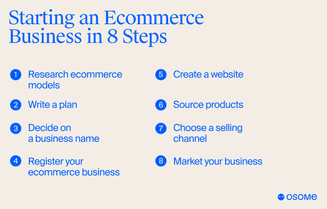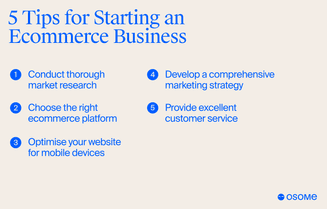Starting an Ecommerce Business in Hong Kong: 8-Step Guide
- Published: 12 June 2024
- 10 min read
- Ecommerce


Gabi Bellairs-Lombard
Author
Gabi creates content that inspires. She's spent her career writing compelling website copy, and now she specialises in product marketing copy. As the voice of our products and features, Gabi makes complex business finance and accounting topics easy to understand. Her top priority is ensuring that her words impact and inspire her readers.
Ready to take the leap into an ecommerce business model in Hong Kong? Cut through the noise with our practical eight-step guide designed to transition you from concept to launch of your new online business seamlessly. Anticipate operational costs, navigate registration, and market efficiently—we’ll walk you through the essentials of establishing your ecommerce business in the heart of Asia.
Key Takeaways
- Starting an ecommerce venture in Hong Kong involves careful planning, including researching ecommerce models, developing a comprehensive plan, choosing a distinctive business name, and ensuring legal compliance through registration.
- Creating a successful ecommerce store entails selecting a platform, sourcing products, choosing the right selling channels, and investing in a strategic marketing approach that includes SEO, social media, email campaigns, and potential paid advertising.
- The costs of launching ecommerce companies can vary widely, but building a budget is crucial for guiding financial decisions. Additionally, tips for success in online marketplaces include a focus on market research, a mobile-optimised platform, and providing excellent customer service.
Starting an Ecommerce Business in 8 Steps
Hong Kong’s dynamic digital ecosystem is a promising platform for ecommerce businesses. However, the journey of building an online store necessitates meticulous planning and strategic decisions. Each step, from analysing ecommerce models to marketing your venture to deciding on a shipping strategy and managing inventory, is instrumental in navigating your ecommerce journey towards a successful business.
The world of ecommerce can appear intimidating, but there’s no need to worry. We have drafted an extensive eight-step guide to direct you through this unfamiliar territory. By following this guide, you’re laying a robust groundwork for your ecommerce venture and aligning your business for sustained success.
For expert assistance with ecommerce incorporation or accounting services, Osome is here to help you every step of the way.

Step 1. Research ecommerce models
In the vast ocean of ecommerce, deciding your vessel is the first step. Whether it’sBusiness to Business (B2B), Business to Consumer (B2C), or Consumer to Consumer (C2C), each ecommerce business model has its unique advantages and challenges.
Identifying a niche within the ecommerce industry is equally vital. Aligning your business with your expertise, interests, and resources can help you target a specific market segment effectively. To validate your chosen niche, assess the following:
- Demand
- Customer base size
- Price sensitivity
- Competition
Tools like Semrush’s Market Explorer and Keyword Overview can provide valuable data for your analysis.
Step 2. Write a plan
Developing a comprehensive business plan is akin to mapping out a route. This document encapsulates your company’s objectives, market analysis, strategies, and legal and financial intricacies. It serves diverse purposes, such as securing financial backing and providing a clear direction for your team. Your ecommerce business plan should be clear and concise, ideally between 20-25 pages, not including appendices and detailed sections. It should provide an overview of your business, followed by detailed sections on the company, offerings, market analysis, and strategies for marketing and sales.
Perform a SWOT analysis to assess strengths, weaknesses, opportunities, and threats as part of your competitor analysis in the business plan.
Step 3. Decide on a business name
A memorable business name is your brand’s first introduction to the world. The name you choose for your online store can be different from the legal name used during company incorporation. It’s crucial to ensure the name is distinct, not already in use, and compliant with the regulations set by the Companies Registry of Hong Kong.
Tools like a free business name generator can help you create potential names for your online stores. After deciding on a name, checking its availability as a domain, preferably a .com, is a crucial step. Remember, creativity is key if the .com option isn’t available. Alternative top-level domains like .store or .shop can be considered for ecommerce stores.
Step 4. Register your ecommerce business
The process of registering your ecommerce business in Hong Kong encompasses selecting a business structure, settling on a business name, and submitting the necessary incorporation documents to the Companies Registry of Hong Kong. It’s important to remember that certain ecommerce businesses may require a business license to operate legally in Hong Kong, depending on the nature of the goods or services provided.
Additionally, consider opening a virtual business account for quicker payment processing and the ability to handle international transactions. This can also help your ecommerce shop reach new customers and a global audience.
Once registered, remember to meet annual compliance requirements like filing profit tax returns and maintaining accurate business records.
Step 5. Create a website
Your ecommerce website is your virtual ecommerce storefront, and ecommerce enables businesses to explore various ecommerce business ideas. It begins with purchasing a domain name that is representative of your brand. Selecting a suitable website builder like Shopify, Wix, or Squarespace for your ecommerce store, or partnering with an ecommerce company according to the specific requirements of your ecommerce business is crucial.
The website design process should adhere to best practices, including the creation of wireframes, the establishment of a style guide, and SEO optimisation. Prior to launch, comprehensive testing of the website should be conducted to resolve any potential issues.
After the launch, maintaining and marketing the website is important to maximise its value and reach potential customers.
Step 6. Source products
Product sourcing is an integral component of the ecommerce process, which ultimately helps you sell products. Regardless of whether you’re:
- creating your (DIY) own products
- collaborating with manufacturers or wholesalers
- implementing dropshipping
- exploring marketplaces
each strategy brings its unique benefits and factors to consider.
When sourcing products, factors such as the uniqueness of products, control over product quality, and the ability to scale should be considered. Be sure to negotiate supply deals and compare prices to ensure you’re getting the best value for your investment.
Step 7. Choose a selling channel
Selecting the appropriate selling channel is akin to directing your compass towards your intended audience. Each channel, whether it’s your own website, well-known online marketplaces like Amazon, or social media platforms such as the Facebook marketplace, provides distinct advantages.
The choice of your ecommerce channel should align with your business goals and model. It’s important to consider operational and financial implications, such as costs, business requirements, and system integrations when selecting your ecommerce channel. Some factors to consider include:
- Costs associated with the platform
- Ease of use and customisation options
- Integration with other systems (e.g. inventory management, payment gateways)
- Scalability and ability to handle your needs as your business grows
- Customer support and resources available
Employing a third-party logistics provider (3PL) can aid in managing multi-channel fulfilment complexity and optimising performance to ensure business success.
Step 8. Market your business
A meticulously designed digital marketing strategy acts as a driving force for your business, pushing it towards your prospective customers. Some key digital marketing tactics to consider include:
- Effective Search Engine Optimisation or SEO
- Social media marketing
- Email campaigns
- Paid advertising
Each of these tactics plays a vital role in attracting customers and driving sales.
Partnerships with complementary brands or influencers can extend your market reach. Remember, your marketing plans should resonate with your target audience and reflect your brand identity. Regularly evaluate the effectiveness of your marketing efforts and be prepared to adapt as the market evolves.
How Much Does it Cost To Start an Ecommerce Business?
An ecommerce venture is not just a thrilling endeavour; it also constitutes a significant investment. The cost to build your own website can range from $30 to $10,000, depending on your business needs and experience levels. Marketing expenses can also range between $1,000 and $15,000 monthly, depending on the size of your business.
Branding costs, domain name registration, website hosting services, payment gateways, and add-on costs are other factors that contribute to the overall cost of starting an ecommerce venture. Remember, a well-planned budget is your financial compass, guiding your business towards its financial goals.
5 Tips To Start an Ecommerce Business
For new business owners, or those transitioning from brick and mortar stores, launching an ecommerce venture in Hong Kong can be an exhilarating but complex journey. Navigating it successfully requires a blend of strategic planning, market understanding, and customer-centric practices. To help you set sail, we’ve compiled five practical tips that can steer your ecommerce venture toward success.
From conducting thorough market research to providing excellent customer service, these tips are designed to offer a holistic view of running a successful ecommerce venture. Let’s dive deeper into each of these tips and understand how they can contribute to your ecommerce success story.

1 Conduct thorough market research
Conducting thorough market research is like scanning the horizon with a telescope. It helps you understand industry trends, competitors, and customer preferences. Online market research can help identify points of friction in the buyer’s journey and improve website usability and customer experience and gain loyal customers.
Use tools like Google Trends to analyse product interest and determine seasonality. Social media platforms are valuable sources of consumer insights, where industry influencers, relevant hashtags, and competitor sentiments can be monitored. Remember, good decisions are rooted in good data.
2 Choose the right platform
Selecting the appropriate ecommerce platform mirrors the choice of the right ship for your voyage. It significantly impacts the operation and success of your business. Many new ecommerce businesses prefer to use SaaS solutions due to their low entry cost, lack of technical complexities, and scalable infrastructure.
When choosing an online platform, consider the following factors:
- Efficiency
- Ease of product management
- Rich app marketplace
- Centralised channel management
The chosen platform should be scalable and customisable to accommodate business growth and unique requirements.
3 Optimise for mobile
In the age of smartphones, a mobile-optimised website is not just a luxury, it’s a necessity for any online business. With over 60% of all online purchases made through mobile devices, it’s crucial to offer a seamless experience on smartphones and tablets, especially in today’s competitive online marketplace.
Mobile optimisation can lead to better search engine rankings as search engines like Google favour mobile-friendly websites. Keep testing and monitoring mobile analytics to ensure that your optimisation efforts are effective and to identify areas for improvement.
4 Develop a comprehensive marketing strategy
A comprehensive marketing strategy includes the following tactics:
- SEO (Search Engine Optimisation)
- SMM
- Email marketing
- Paid advertising
Each of these tactics plays a vital role in attracting customers and driving sales.
Consider partnerships with influencers or complementary brands to extend your market reach. Utilising user-generated content can provide social proof and encourage consumer trust in your brand. Remember, your business strategy should resonate with your target audience and reflect your brand identity.
5 Provide excellent customer service
In the digital realm of ecommerce, customer service is pivotal in fostering trust and loyalty among customers who never have a physical interaction with the brand. Personalisation in customer service is essential, and providing omnichannel support can create a seamless customer experience and delightful customer relationships.
Investing in technology like services online:
- live chat software
- advanced call handling software
- chatbots
- AI
Ecommerce platforms can replicate the personalised service found in traditional retail or in physical storefronts. Remember, clear shipping and return policies, including shipping costs, are vital to customer satisfaction, and transparency is key to meeting customer expectations. Through personalised service, you can also encourage customers to return again and again to your ecommerce shop.
Summary
Starting an ecommerce business in Hong Kong might seem like a daunting task, but with a comprehensive plan and practical tips, it becomes a navigable journey towards success. From researching ecommerce models and choosing a memorable name for your business to creating a user-friendly website and providing excellent customer service, each step plays a crucial role in shaping your ecommerce venture. Remember, every successful journey begins with a single step. So, embark on your ecommerce journey with confidence, armed with the right knowledge, and set sail towards your business horizon.
FAQ
What are the steps to start an ecommerce business in Hong Kong?
To start an ecommerce venture in Hong Kong, you should research ecommerce models, write a business plan, register your business, create a website, source products, choose a selling channel, and focus on marketing your business effectively. Good luck on your entrepreneurial journey!
What are the costs associated with an ecommerce business?
Starting an ecommerce venture involves costs such as website development, marketing, branding, domain registration, hosting, payment gateways, and additional website expenses. These are all essential for establishing a successful online business.
How important is mobile optimisation for an ecommerce website?
Mobile optimisation is crucial for ecommerce because over 60% of online purchases are done through mobile devices. Mobile optimisation also improves search engine rankings. Don't overlook the significance of mobile optimisation for your ecommerce site.
How can I choose the right ecommerce platform for my business?
When choosing an ecommerce platform, consider factors like ease of product management, a rich app marketplace, and centralised channel management. The platform should also be scalable and customisable to accommodate business growth and unique requirements.
How can customer service contribute to the success of my ecommerce business?
Providing excellent customer service through personalisation and omnichannel support can help build trust and loyalty among customers, ultimately contributing to the success of your business idea.
Get expert tips and business insights
By clicking, you agree to our Terms & Conditions,Privacy and Data Protection Policy
We’re using cookies! What does it mean?






